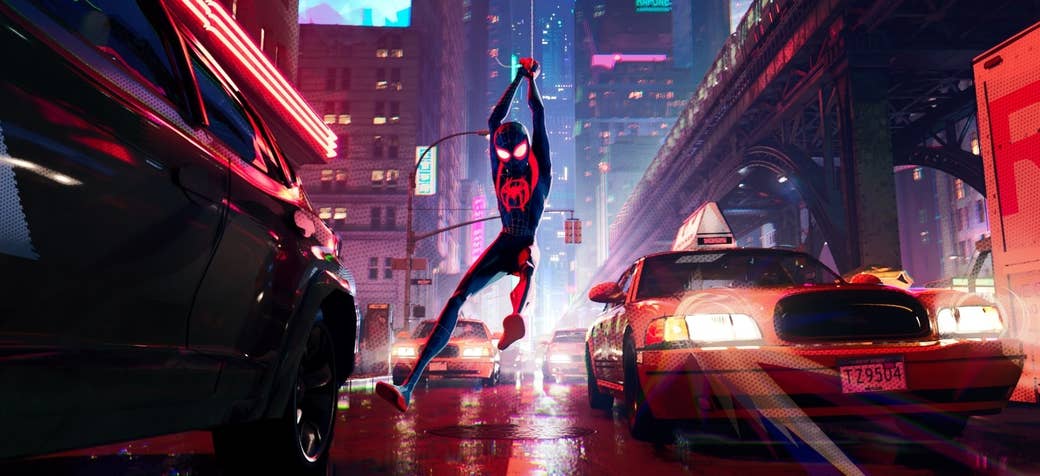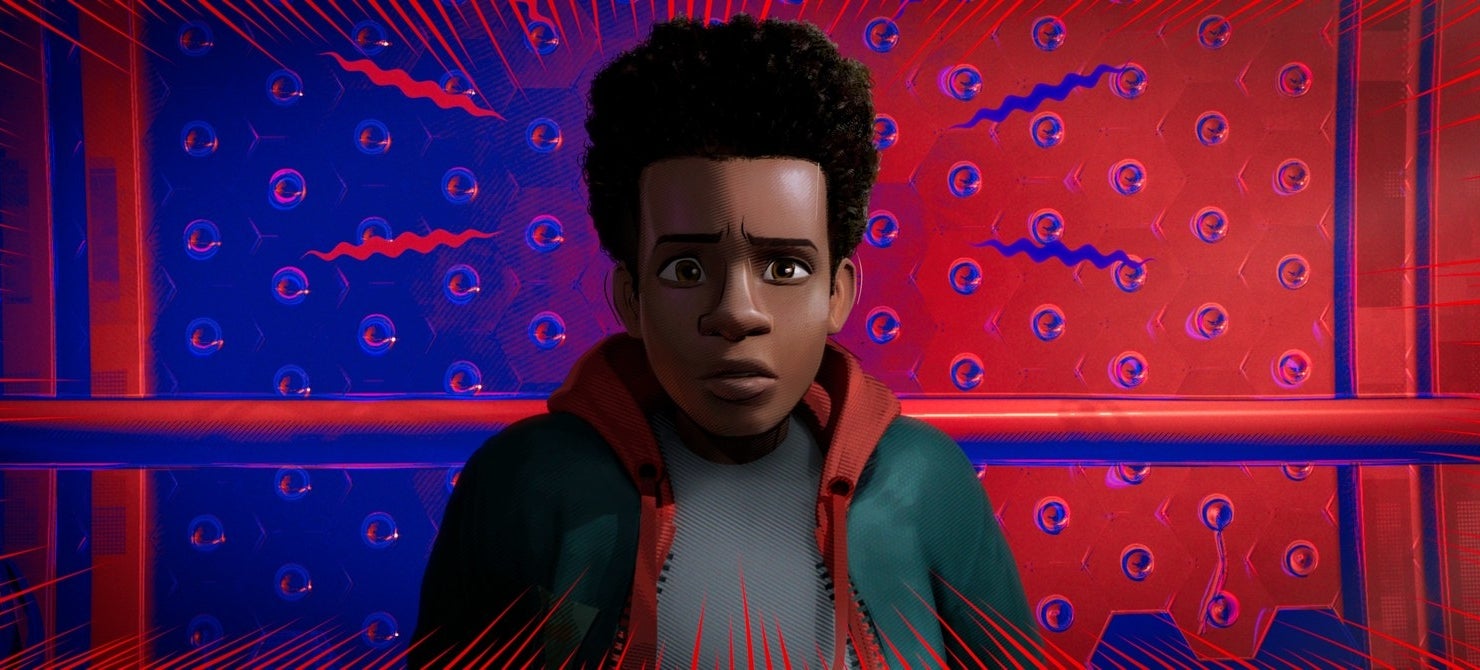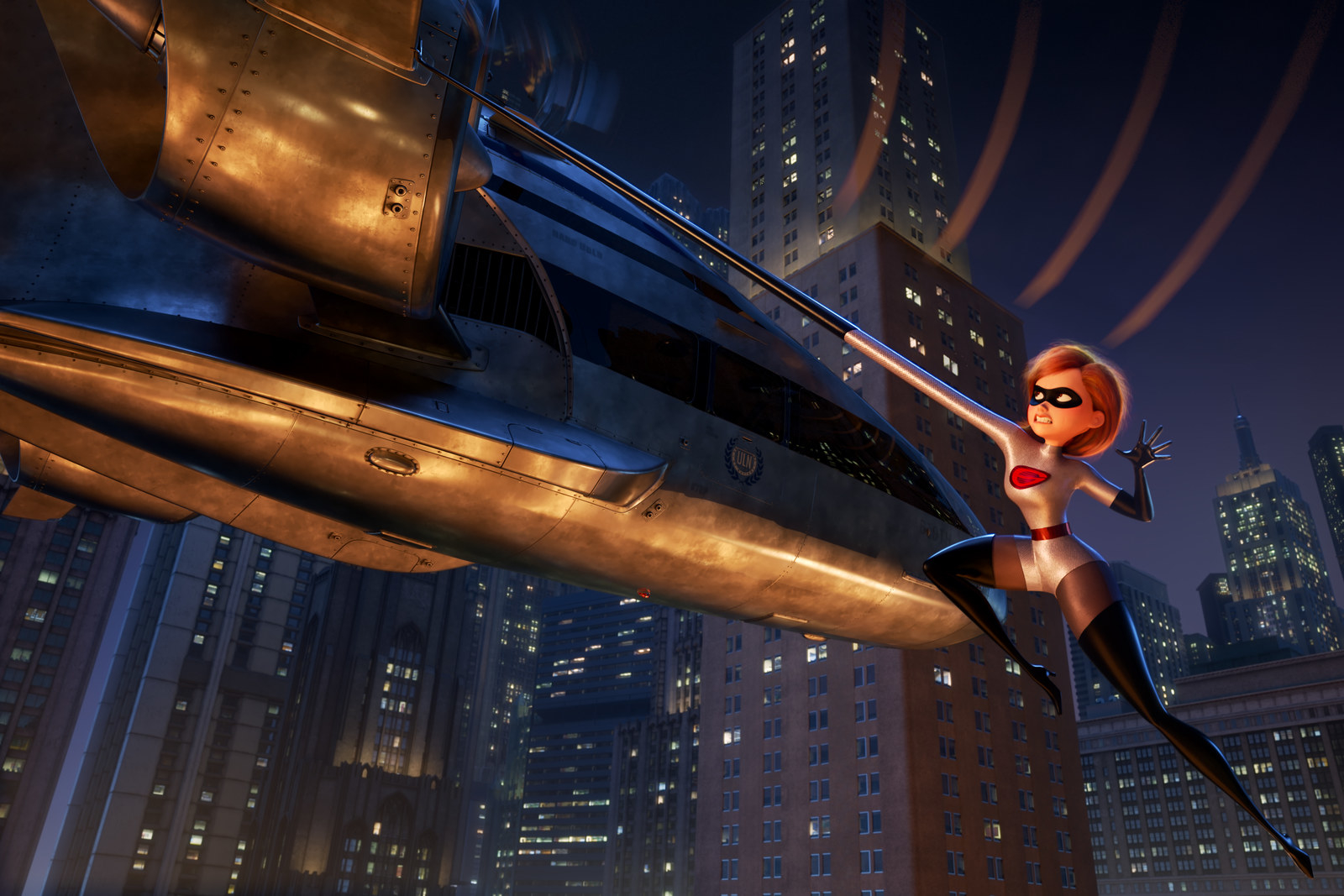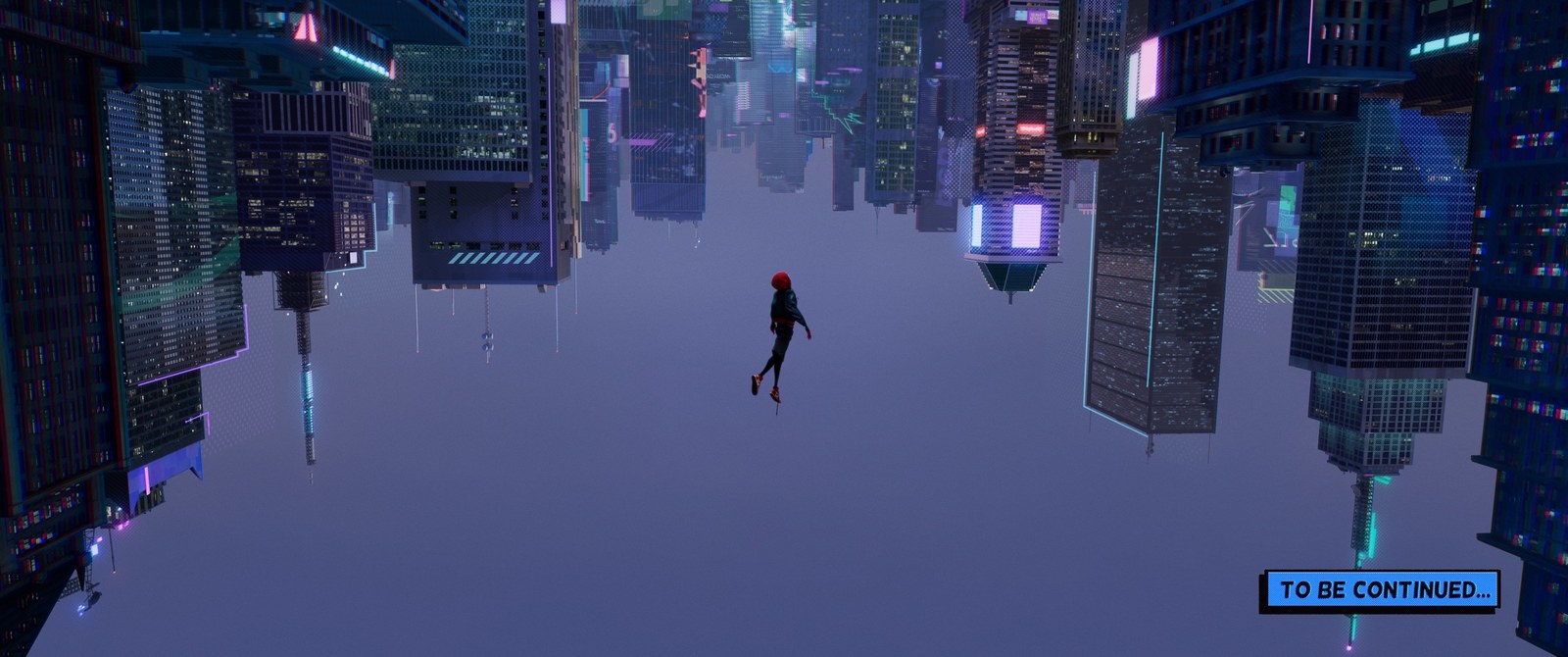
Animation used to be the go-to medium for superheroes onscreen. It seemed, for a long time, like the only way to depict these larger-than-life comic book characters and their outsize antics without compromise. Michael Keaton in Tim Burton’s 1989 Batman was so restricted by his bulky costume that he had to turn his whole body to look at anything, but the cartoon version in Batman: The Animated Series (which aired on Fox from 1992 to 1995) moved with total fluidity. The monstrous Man-Bat of the first episode feels like a declaration of purpose, an argument for the show’s necessity: Where else could the winged beast be so convincingly depicted? It only makes sense — the villain has gone from being drawn for the page to being drawn for the screen.
Of course, that was then. Now, technology has evolved to the point where our heroes regularly engage CGI armies that stretch beyond the horizon. Live action is the dominant mode for movie and TV superheroes, whether they fight for DC or Marvel, who embrace the gravitas that comes with flesh-and-blood actors over animation’s exaggerated expression.
For years, that shift has gone largely unchallenged, and why would it be? The box office receipts only pile higher as the list of planned cinematic universe crossovers gets longer. But cartoon superheroes mounted a remarkable big screen comeback in 2018, which saw the release of Pixar’s belated sequel to The Incredibles and culminated with Spider-Man: Into the Spider-Verse, a film so vibrant and joyous that it makes you wonder if all superheroes would be better off in animation. A film like this — which just won a Golden Globe for Best Animated Feature, and is nominated for an Oscar in the same category — forces us to question animation’s second-place status, relegated to a supposedly juvenile niche in our brand-obsessed, franchise-pushing filmmaking climate.
Into the Spider-Verse follows Miles Morales (voiced by Shameik Moore), a black and Puerto Rican teen living in Brooklyn, as he deals with his own awakening spider-powers. In the face of a fracturing multiverse, he’s tutored by a burned-out Peter B. Parker (Jake Johnson), an older version of the classic Spider-Man who is sucked, sweatpants and all, out of his own universe and into the one inhabited by Miles.

Same goes for the story’s other Spider-folks, sourced from various Marvel comics: a punk rock Gwen Stacy as Spider-Gwen (Hailee Steinfeld), talking cartoon pig Peter Porker (formerly a spider bitten by a radioactive pig) as Spider-Ham (John Mulaney), a trenchcoated 1930s detective Spider-Man Noir (Nicolas Cage!), and a far-future Japanese schoolgirl mech pilot named Peni Parker (Kimiko Glenn) as SP//dr.
The film — directed by Bob Persichetti, Peter Ramsey, and Rodney Rothman — is bursting with touches that nod to its hand-drawn source material, some as obvious as page-turn transitions and others so subtle that they’re hard to catch without pausing a trailer or video clip. There are Ben-Day dots and thought bubbles, visible speed lines and sound effects; the pleasing choppiness of the characters’ motions simulates the emphatic style of hand-drawn animation, a little reminiscent of the way producers Phil Lord (who outlined the story and cowrote the screenplay with Rothman) and Christopher Miller simulated stop-motion in 2014’s The Lego Movie.
The whole film plays like the wild, lovingly crafted experiment it is.
In the age of live-action heroes, it seems only fitting for Into the Spider-Verse to upend the heightened semi-realism of its cartoon forerunners, like the Batman and Spider-Man TV shows, by totally departing from reality — breaking many of the established rules of CGI animation in the process. The whole film plays like the wild, lovingly crafted experiment it is. In an interview with the Verge, Persichetti and Ramsey said, “We’re just trying to embrace what the tools can give us to push how exciting and dynamic can it get. How much can we exaggerate action or visuals or color … that no live-action Marvel movie could ever do.”
In a detailed look at some of the film’s stylistic choices, Slashfilm’s Siddhant Adlakha calls it “a story about art,” and it’s a difficult one to imagine in any medium outside animation. Different multiverse characters are rendered in different art styles: Spider-Ham moves with a bouncy Looney Tunes aesthetic, Peni Parker evokes anime, Spider-Man Noir lives in grayscale (and is consequently baffled by a Rubik’s cube). Even the villains get fun, exaggerated designs, like a hulking Green Goblin with tiny wings or a Kingpin bigger and wider than the van he emerges from.

Despite all the comedic asides stuffed into every mainstream Marvel movie these days, and the ways in which some of them have managed to expand the parameters of the superhero genre, the go-for-broke postmodern premise of Into the Spider-Verse would almost certainly be deemed too out-there for live action. The movie revels in that fundamental absurdity, never feeling the need to “ground” itself for fear of alienating its audience. As Rothman says in the Verge interview, “One nice thing about telling this story with animation is that there isn’t a point of disbelief for the audience.”
You begin to wonder what might have been lost in translation all these years.
So many superhero films attempt to cram imaginative source material — outlandish designs, powers, and origin stories made to be drawn on the page — into live action by muting the colors and toning down anything that could be described as cartoonish. Tights become body armor in the bid for realism. You can see that everywhere from Christopher Nolan’s overtly realistic Dark Knight movies to X-Men still taking steps away from black leather with grittier updates like Logan; it’s visible in the grim exploits of Marvel’s Netflix heroes, in DC’s entire strategy before Wonder Woman and Aquaman, and in the shades of gray smeared all over the latest Avengers movie.
After all, both Tobey Maguire and Andrew Garfield came and went before the MCU contrived a technological reason for the eyes on Spider-Man’s mask to finally emote. To watch Into the Spider-Verse is to see a deeply unflattering light shone on many of the film’s live-action contemporaries and predecessors. You begin to wonder what might have been lost in translation all these years, what the unrestrained creativity of animation might have rendered beyond a gradual ramp-up to the more fantastical live action of Thor: Ragnarok or Guardians of the Galaxy, films that nonetheless distance their unbelievable antics from the world we know by taking place in outer space. It’s hard not to ask why it’s taken so long to get a film like this, and whether superhero movies are outright better-suited for the medium they seemingly outgrew.

There is, of course, no linear relationship between animation and quality. Plenty of mediocre cartoons arrive in theaters year after year. But it doesn’t seem like an accident that some of the most engaging portrayals of superheroes this year have come from animation. Though Pixar’s Incredibles 2 lacks the same visual experimentation as Spider-Verse, its action is just as lively and exaggerated as in its 2004 predecessor. And the sequel dropping in the middle of the current superhero boom only highlights that dynamic, jazzy energy.
Brad Bird’s direction again demonstrates animation’s affinity for eye-popping powers, like a motorcycle chase that (literally) stretches Elastigirl’s powers to their formidable limits as she grinds through a construction site and bounces between buildings to land on a speeding train. The characters — who look less like humans than a bunch of shapes jammed together and slid into bright red tights — don’t even seem to exist in our world, set instead against an impossible retrofuturist landscape. And for a series that famously decried the impracticality of capes, The Incredibles has no qualms about translating other fantastical facets of superheroism through the characters’ oddball abilities (spitting lava, crushing stuff, being an owl) and superb mesh of action with comedy. The more over-the-top things get, the more they contrast with the characters’ uneasy suburban existence, as well as with Hollywood’s general approach to live-action superheroes.
And yet, despite the versatility demonstrated in Incredibles 2 and especially Into the Spider-Verse, Hollywood’s affinity for live action as the more prestigious, serious medium continues to win out. Stories that lend themselves so well to animation continue to be told — and retold — without it, as if the gulf between the two formats may be filled, given enough time and money. Though this is most apparent in superhero films, it can also been seen in another Disney-dominated field: their remakes of their own classic animated films, which find decidedly mixed success in the translation process.
We’ve gotten used to assuming that bright cartoon colors are for kids, while real grown-ups will only respect washed-out realism.
Jon Favreau’s 2016 update of The Jungle Book, for example, takes the 1967 Disney film, — essentially just a thinly plotted series of animal encounters — and adds a more structured, urgent storyline and new action scenes while moving it all into a realistic world. Though the animals still talk and (poorly) sing with the help of CGI, they now look like real animals. The original Jungle Book featured some of Disney’s most expressive animation, and nearly all of it disappears in the push for realism. As a re-creation rather than a reworking of the original, the 2017 live-action Beauty and the Beast, starring Emma Watson, is even more superfluous. Where The Jungle Book has only two renditions of classic Disney songs, Beauty and the Beast includes all of them, in addition to some new ones. The whole busy, gaudy venture suffers in the overt comparison, and loses a host of charming visual jokes. The film’s stiff rendition of the beast (Dan Stevens, under a heavy load of fake fur and CGI) is certainly more realistic, but it could hardly be called more lively.
Now we have even more of these Disney simulacra to look forward to, from Aladdin — coming in May — to the hugely hyped, star-studded “photorealistic” CGI Lion King due this summer. And depending on box office returns, there will presumably be more to follow. If these movies aren’t very good substitutes for the hand-drawn originals, they don’t necessarily have to be. The obvious difference between the two styles — as well as the extensive homage each Disney remake in particular pays to the cartoon that spawned it — positions a live-action or CGI version as a “reimagining” that’s explicitly meant to exist alongside the original. The appeal rests in watching a version that’s new, yet not too new.
Remakes like this also speak to an old stigma against animation (that clearly looks like animation) as being for children, which has been at play in superhero universes as well. We’ve gotten used to assuming that bright cartoon colors are for kids — whether in comic books or Saturday-morning TV — while real grown-ups will only respect washed-out realism. If neo-Disney remakes offer a nostalgic escape back to childhood for those who grew up with the originals, they do so while emphasizing the fact that you, an adult, are no longer watching a cartoon. And for what respect Disney and Pixar’s animation still commands, it’s respect with the family-friendly caveat that it can be enjoyed by adults, even if it’s created with children firmly in mind. Even the most critically acclaimed animated movies, like last year’s Coco, tend to be held up as transcendent of the medium rather than as brilliant examples of its possibility.
Most moviegoers want to be able to easily imagine ourselves within our escapism, and what better way to compensate for the limitations and hang-ups of the adult imagination than doing it “for real”? But Hollywood’s inclination toward live-action interpretations of originally animated or illustrated stories seemingly has less to do with art than commerce, and the brand-obsessed push for the broadest possible appeal.

Despite rave reviews, Into the Spider-Verse is hardly on track to outgross the widely panned (if, to some, delightfully weird) Venom, starring Tom Hardy, which came out in October. Part of that certainly speaks to Venom’s popularity as a character, but it’s also totally consistent with how superhero movies hit it biggest, in terms of cultural cachet, once they went live action and built an interconnected universe of other live-action films. As the millions keep rolling in, the related prestige is such that you can even mount a plausible Oscar campaign for some of these movies and their stars. Live action neatly skirts the stigma of being a cartoon while capitalizing on the name value.
In that light, animation begins to seem like little more than a breeding ground for future brands, a waiting room for live-action legitimacy. 2017’s Ghost in the Shell — a live-action remake of Mamoru Oshii’s anime classic — was intended as a blockbuster meant to take the next logical step: Comic book brands are popular, so anime and manga could follow suit. Yet even discounting the whitewashing controversy over Scarlett Johansson’s casting, the remake looks limp and textureless next to the iconic images of the original.
Animated films begin to function like the inverse of the realistic Disney remake: a supplement to the “real thing.”
Next month will bring James Cameron’s Alita: Battle Angel, which grafts enormous digital anime eyes onto an approximate version of star Rosa Salazar’s face so that she may match the source material. A live-action Cowboy Bebop TV show is in the works, as is one for Avatar: The Last Airbender. Maybe Pixar will remain sacred for another few decades, but at some point, you have to wonder: How many more millions would a live-action Incredibles gross, down the line?
In this myopic, profitable climb to the top of the box office — alongside the superheroes, the anime adaptations, the Aladdin genie done Big Willie Style — animated films begin to function like the inverse of the realistic Disney remake: a supplement to the “real thing.” Even Into the Spider-Verse, such a thrilling expression of cartoons’ possibility, isn’t much more than a side project next to Sony’s other Spider-Verse. There are already plans for a live-action series that begins with Venom and its sequels, expands with a film starring Jared Leto as Morbius the Living Vampire, and presumably includes a crossover with the “real” Spider-Man one day, once Marvel is finished with him.
Rather than propping up the medium it increasingly strips for parts, the brand-crazed engine of megabudget filmmaking more often works to further sideline animation as a stopgap or supplement to live action. The charm, personality, and imagination that sparked so much of our interest to begin with get ironed out in the relentless pursuit of an efficient, Disneyfied monoculture. And so, as we’re subjected to an increasing number of live-action fantasies year after year, a movie like Spider-Man: Into the Spider-Verse reminds us of just how much room there is in the multiverse for new stories, told in amazing ways — if anyone cares to make them. ●
Steven Nguyen Scaife is a freelance writer whose work has appeared at the Awl, Slant Magazine, the Hollywood Reporter, the Verge, Polygon, and others. He is based somewhere in Ohio.
